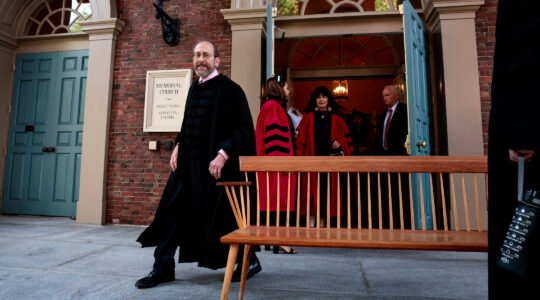NEW YORK (JTA) — A treasure trove of American Jewish literary news and opinion spanning the second half of the 20th century is now available as a free digital archive.
Launched in honor of the 90th anniversary of the Jewish Book Council, the searchable archive of the Jewish Book Annual is the culmination of a multi-year partnership between the council and the Center for Jewish History, which provided the technological resources to digitize the 56 issues of the journal through its Gruss Lipper Digital Laboratory.
Published by the Jewish Book Council, or JBC, from 1942 through 1999, the Jewish Book Annual was for many decades a trilingual journal, with distinct sections in English, Hebrew and Yiddish that included a review of the previous year in Jewish literature, a complete bibliography in fiction, nonfiction and children’s books, and essays on important figures and events on the Jewish literary scene.
The inaugural issue emerged against the tragic backdrop of the Nazis’ mass extermination of European Jewry, including its influential writers, artists and scholars who were the source of a vibrant world of Jewish literature and culture. The editors and contributors called on American Jews to take on the mantle of Jewish literature, not just as writers, but as engaged readers as well.
“An age of creative readers makes for literature which is immortal,” wrote Louis Finkelstein, who was then the president of the Jewish Theological Seminary.
The journal evolved over time to an English-only publication and was succeeded by Jewish Book World, the JBC’s quarterly magazine of book reviews, author interviews and editorials.
The questions and concerns that writers grappled with in the mid-20th century are relevant today, according to Naomi Firestone-Teeter, JBC’s executive director. She was struck by an article from the 1940s that worried about American Jews becoming too Americanized.
“It made me laugh. We are talking about the same questions,” she told JTA.
By digitizing their complete collection in partnership with the Center for Jewish History, JBC ensures that this important piece of American Jewish history will not be lost and will now be accessible to scholars and new generations of readers, Firestone-Teeter said.
With essays written for lay readers, often constructed around a theme or trend, the journal presents a portrait of American Judaism through a literary lens of the period.
“Fundamentally, the publication was about the American Jewish community and its members,” said Nat Bernstein, JBC’s manager of digital content and media. “The annual’s writers had their fingers on the pulse of the Jewish community and found ways to reflect that in a literary journal.”
“This was not an ivory tower,” she added. “This was for American Jewish readers.”
CORRECTION: This article misidentified the JBC’s manager of digital content and media. It is Nat Bernstein.
JTA has documented Jewish history in real-time for over a century. Keep our journalism strong by joining us in supporting independent, award-winning reporting.





